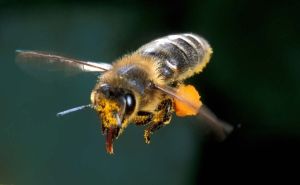
Honeybees
in a hive have fairly identical genes. The queen is the mother, a very
few drones are the fathers, and those drones are closely related to each
other anyway. But "epigenetic" changes in the DNA, those that switch
genes on or off chemically, differ among bees that do different jobs.
And bees can change those chemical switches themselves, when needed.
Under normal circumstances, young worker bees are nurses in the hive,
and turn into foragers as they age, when a chemical changes which genes
are expressed. Scientists can track those changes by the amount and
pattern of methyl (CH3) molecules in their DNA.
Led by
Andrew Feinberg of Johns Hopkins University in Baltimore, Maryland, and
Gro Amdam of Arizona State University in Tempe, the researchers coaxed
forager bees back into nursing roles by removing all the nurses from the
hive while the foragers were out looking for pollen. When the foragers
returned, they noticed the lack of nurses, and about half of them took
on nursing roles. Examination of the methylation patterns in DNA from
their brain cells showed that these too had switched back to the pattern
associated with nurses.
“What is exciting is that the genes that
change back are the same genes that changed in the other direction
initially — and the same ones that would regulate epigenetic behaviour,”
says Feinberg.
Gene Robinson, a bee researcher at the University
of Illinois at Urbana-Champaign, who was not involved in the research,
says that although the paper does not necessarily prove that epigenetic
mechanisms cause behavioral differences, “it demonstrates for the first
time that if behavior is reversible so is the methylation”.
Further research may determine exactly what triggers the correllation.
More
 Honeybees
in a hive have fairly identical genes. The queen is the mother, a very
few drones are the fathers, and those drones are closely related to each
other anyway. But "epigenetic" changes in the DNA, those that switch
genes on or off chemically, differ among bees that do different jobs.
And bees can change those chemical switches themselves, when needed.
Under normal circumstances, young worker bees are nurses in the hive,
and turn into foragers as they age, when a chemical changes which genes
are expressed. Scientists can track those changes by the amount and
pattern of methyl (CH3) molecules in their DNA.
Honeybees
in a hive have fairly identical genes. The queen is the mother, a very
few drones are the fathers, and those drones are closely related to each
other anyway. But "epigenetic" changes in the DNA, those that switch
genes on or off chemically, differ among bees that do different jobs.
And bees can change those chemical switches themselves, when needed.
Under normal circumstances, young worker bees are nurses in the hive,
and turn into foragers as they age, when a chemical changes which genes
are expressed. Scientists can track those changes by the amount and
pattern of methyl (CH3) molecules in their DNA.
No comments:
Post a Comment